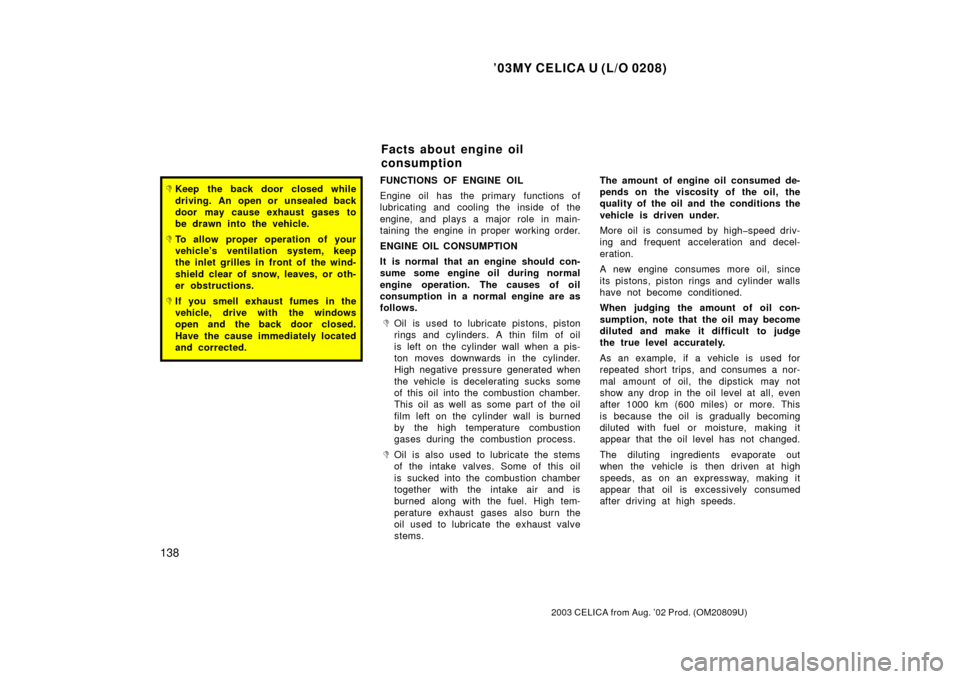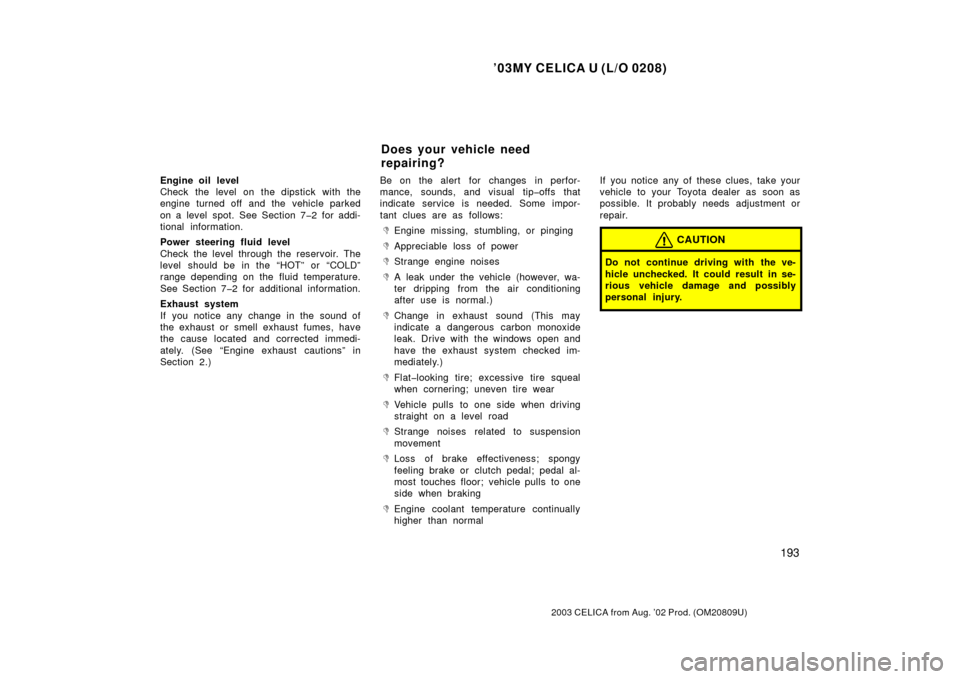Page 142 of 249

’03MY CELICA U (L/O 0208)
138
2003 CELICA from Aug. ’02 Prod. (OM20809U)
�Keep the back door closed while
driving. An open or unsealed back
door may cause exhaust gases to
be drawn into the vehicle.
�To allow proper operation of your
vehicle’s ventilation system, keep
the inlet grilles in front of the wind-
shield clear of snow, leaves, or oth-
er obstructions.
�If you smell exhaust fumes in the
vehicle, drive with the windows
open and the back door closed.
Have the cause immediately located
and corrected.
FUNCTIONS OF ENGINE OIL
Engine oil has the primary functions of
lubricating and cooling the inside of the
engine, and plays a major role in main-
taining the engine in proper working order.
ENGINE OIL CONSUMPTION
It is normal that an engine should con-
sume some engine oil during normal
engine operation. The causes of oil
consumption in a normal engine are as
follows.
�Oil is used to lubricate pistons, piston
rings and cylinders. A thin film of oil
is left on the cylinder wall when a pis-
ton moves downwards in the cylinder.
High negative pressure generated when
the vehicle is decelerating sucks some
of this oil into the combustion chamber.
This oil as well as some part of the oil
film left on the cylinder wall is burned
by the high temperature combustion
gases during the combustion process.
�Oil is also used to lubricate the stems
of the intake valves. Some of this oil
is sucked into the combustion chamber
together with the intake air and is
burned along with the fuel. High tem-
perature exhaust gases also burn the
oil used to lubricate the exhaust valve
stems.The amount of engine oil consumed de-
pends on the viscosity of the oil, the
quality of the oil and the conditions the
vehicle is driven under.
More oil is consumed by high�speed driv-
ing and frequent acceleration and decel-
eration.
A new engine consumes more oil, since
its pistons, piston rings and cylinder walls
have not become conditioned.
When judging the amount of oil con-
sumption, note that the oil may become
diluted and make it difficult to judge
the true level accurately.
As an example, if a vehicle is used for
repeated short trips, and consumes a nor-
mal amount of oil, the dipstick may not
show any drop in the oil level at all, even
after 1000 km (600 miles) or more. This
is because the oil is gradually becoming
diluted with fuel or moisture, making it
appear that the oil level has not changed.
The diluting ingredients evaporate out
when the vehicle is then driven at high
speeds, as on an expressway, making it
appear that oil is excessively consumed
after driving at high speeds.
Facts about engine oil
consumption
Page 197 of 249

’03MY CELICA U (L/O 0208)
193
2003 CELICA from Aug. ’02 Prod. (OM20809U)
Engine oil level
Check the level on the dipstick with the
engine turned off and the vehicle parked
on a level spot. See Section 7�2 for addi-
tional information.
Power steering fluid level
Check the level through the reservoir. The
level should be in the “HOT” or “COLD”
range depending on the fluid temperature.
See Section 7�2 for additional information.
Exhaust system
If you notice any change in the sound of
the exhaust or smell exhaust fumes, have
the cause located and corrected immedi-
ately. (See “Engine exhaust cautions” in
Section 2.)Be on the alert for changes in perfor-
mance, sounds, and visual tip�offs that
indicate service is needed. Some impor-
tant clues are as follows:
�Engine missing, stumbling, or pinging
�Appreciable loss of power
�Strange engine noises
�A leak under the vehicle (however, wa-
ter dripping from the air conditioning
after use is normal.)
�Change in exhaust sound (This may
indicate a dangerous carbon monoxide
leak. Drive with the windows open and
have the exhaust system checked im-
mediately.)
�Flat�looking tire; excessive tire squeal
when cornering; uneven tire wear
�Vehicle pulls to one side when driving
straight on a level road
�Strange noises related to suspension
movement
�Loss of brake effectiveness; spongy
feeling brake or clutch pedal; pedal al-
most touches floor; vehicle pulls to one
side when braking
�Engine coolant temperature continually
higher than normalIf you notice any of these clues, take your
vehicle to your Toyota dealer as soon as
possible. It probably needs adjustment or
repair.
CAUTION
Do not continue driving with the ve-
hicle unchecked. It could result in se-
rious vehicle damage and possibly
personal injury.
Does your vehicle need
repairing?
Page 209 of 249
’03MY CELICA U (L/O 0208)
205
2003 CELICA from Aug. ’02 Prod. (OM20809U)
ENGINE OIL SELECTION
“Toyota Genuine Motor Oil” is filled in
your Toyota vehicle. Use Toyota approved
“Toyota Genuine Motor Oil” or equivalent
to satisfy the following grade and viscos-
ity.
Oil grade: API grade SL “Energy�Conserving” or
ILSAC multigrade engine oil
Recommended viscosity: SAE 5W�30
Outside temperature
SAE 5W�30 is the best choice for good
fuel economy and good starting in cold
weather.
If SAE 5W�30 is not available, SAE
10W�30 may be used. However, it
should be replaced with SAE 5W�30 at
the next oil change.
API service symbol
ILSAC certification mark
Page 240 of 249

’03MY CELICA U (L/O 0208)
236
2003 CELICA from Aug. ’02 Prod. (OM20809U)
BATTERY
Open voltage
∗ at 20�C (68 �F):
12.6—12.8 V Fully charged
12.2—12.4 V Half charged
11.8—12.0 V Discharged
∗: Voltage that is checked 20 minutes af-
ter the key is removed with all the lights
turned off
Charging rates: 5 A max.
CLUTCH
Pedal free play, mm (in.): 5—15 (0.2—0.6)
Fluid type: SAE J1703 or FMVSS No.116 DOT 3
MANUAL TRANSAXLE
Oil capacity, L (qt., Imp. qt.): 1ZZ�FE engine 1.9 (2.0, 1.7)
2ZZ�GE engine 2.3 (2.4, 2.0)
Oil type: Gear oil API GL�4 or GL�5
Recommended oil viscosity: SAE 75W�90 AUTOMATIC TRANSAXLE
Fluid capacity (drain and ref
ill),
L (qt., Imp. qt.):
1ZZ�FE engineUp to 2.9 (3.1, 2.6)
2ZZ�GE engine
Up to 3.5 (3.7, 3.1)
Fluid type: Toyota Genuine ATF Type T�IV
Change automatic transmission fluid only
as necessary.
Generally, it is necessary to change auto-
matic transmission fluid only if your ve-
hicle is driven under one of the Special
Operating Conditions listed in your
“Scheduled Maintenance Guide” or “Own-
er ’s Manual Supplement”. When changing
the automatic transmission fluid, use only
“Toyota Genuine ATF Type T�IV” (ATF
JWS3309 or NWS6500) to aid in assuring
optimum transaxle performance.
Notice: Using automatic transmission
fluid other than “Toyota Genuine ATF
Type T�IV” may cause deterioration in
shift quality, locking up of your trans-
mission accompanied by vibration, and
ultimately damage the automatic trans-
mission of your vehicle.
Please contact your Toyota dealer for fur-
ther details. BRAKES
Minimum pedal clearance when depressed
with the force of 490 N (50 kgf, 110 lbf)
with the engine running, mm (in.):
85 (3.4)
Pedal free play, mm (in.): 1—6 (0.04—0.24)
Pad wear limit, mm (in.): 1.0 (0.04)
Lining wear limit, mm (in.): 1.0 (0.04)
Parking brake adjustment when pulled with
the force of 196 N (20 kgf, 44 lbf): 7—8 clicks
Fluid type: SAE J1703 or FMVSS No.116 DOT 3
STEERING
Wheel free play: Less than 30 mm (1.2 in.)
Power steering fluid type: Automatic transmission fluid DEXRON �II
or III